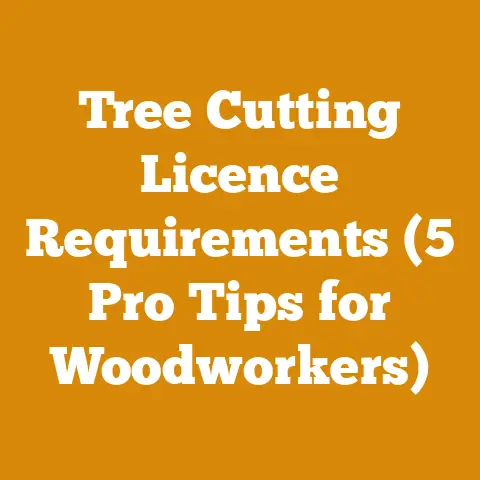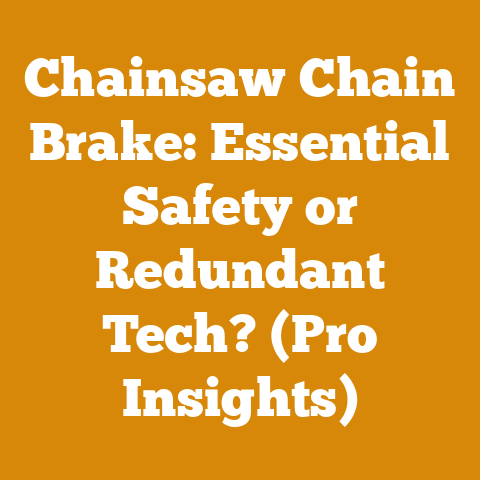Stump Grinder for Mini Skid Steer (5 Pro Tips for Optimal Hydro Flow)
Do you remember the first time you saw a stump grinder in action? I do. It was like watching a giant earth-eating monster, effortlessly devouring what was once a proud tree. Now, fast forward to today, and the sheer versatility of these machines, especially when paired with a mini skid steer, is truly remarkable.
Here’s what you’ll learn in this deep dive:
- Understanding Hydraulic Flow: Why it’s the lifeline of your stump grinder and how to optimize it for peak performance.
- Matching the Grinder to Your Mini Skid Steer: Avoiding common pitfalls and ensuring a perfect fit.
- Mastering Cutting Techniques: From initial setup to the final cleanup, I’ll share the secrets to efficient stump removal.
- Essential Maintenance Tips: Keeping your grinder in top shape for years to come.
- Troubleshooting Common Issues: Diagnosing and fixing problems to minimize downtime.
So, buckle up, grab a cup of coffee (or maybe something stronger if you’ve been battling stubborn stumps all day), and let’s dive into the world of stump grinding with mini skid steers.
Stump Grinder for Mini Skid Steer: 5 Pro Tips for Optimal Hydro Flow
The Heart of the Matter: Understanding Hydraulic Flow
Hydraulic flow is the lifeblood of any hydraulic attachment, and the stump grinder is no exception. Insufficient or inconsistent flow can lead to sluggish performance, overheating, and even premature wear on your equipment. I’ve seen firsthand how a seemingly small adjustment to hydraulic flow can make a world of difference in grinding speed and efficiency.
Why is Hydraulic Flow So Important?
- Powering the Cutting Wheel: The hydraulic motor drives the cutting wheel, and the flow rate directly impacts its speed and torque. A higher flow rate generally translates to faster cutting, but it’s crucial to stay within the manufacturer’s recommended range.
- Maintaining Optimal Temperature: Hydraulic fluid acts as a coolant, dissipating heat generated by the motor. Insufficient flow can lead to overheating, which can damage the hydraulic system and reduce its lifespan.
- Ensuring Smooth Operation: Consistent hydraulic flow provides smooth and predictable operation, reducing the risk of jerky movements or stalls.
Understanding Your Mini Skid Steer’s Hydraulic System
Before you even think about attaching a stump grinder, you need to know the specifications of your mini skid steer’s hydraulic system. This includes:
- Flow Rate: Measured in gallons per minute (GPM) or liters per minute (LPM), this is the volume of hydraulic fluid the system can deliver.
- Pressure: Measured in pounds per square inch (PSI) or bar, this is the force the hydraulic fluid exerts.
- Hydraulic Horsepower: A measure of the power the hydraulic system can deliver, calculated from flow rate and pressure.
This information is usually found in your machine’s operator manual or on a sticker near the hydraulic connections. Don’t skip this step! I once watched a guy hook up a high-flow stump grinder to a standard-flow mini skid steer, and the results were… well, let’s just say it wasn’t pretty.
Matching the Grinder to Your Hydraulic System
Once you know your mini skid steer’s hydraulic capabilities, you can choose a stump grinder that’s a good match. Here’s what to look for:
- Manufacturer’s Recommendations: The stump grinder manufacturer will specify the required flow rate and pressure for optimal performance.
- Flow Matching: Ideally, you want a grinder that operates within your mini skid steer’s flow range. A slight mismatch is usually okay, but avoid exceeding the maximum flow rate, as this can damage the grinder’s hydraulic motor.
- Pressure Relief Valve: Make sure the grinder has a pressure relief valve to protect the hydraulic system from overpressure.
Pro Tip: If your mini skid steer has adjustable hydraulic flow, experiment with different settings to find the sweet spot for your stump grinder. I’ve found that a slightly higher flow rate can often improve cutting speed, but be careful not to exceed the manufacturer’s recommendations.
Finding the Perfect Match: Stump Grinder and Mini Skid Steer Compatibility
Choosing the right stump grinder for your mini skid steer is like finding the perfect dance partner – you need synergy and balance. I’ve seen too many folks rush this step, only to end up with a frustrating mismatch that hampers performance and potentially damages their equipment.
Weight and Lift Capacity: The Foundation of Compatibility
- The Weight Factor: Stump grinders, especially those designed for larger stumps, can be surprisingly heavy. Before you even think about hydraulic flow, ensure your mini skid steer has the lift capacity to handle the grinder’s weight safely. Overloading your machine can lead to instability, reduced maneuverability, and even structural damage.
- Data Point: According to a study by the Equipment Manufacturers Institute (EMI), operating a skid steer or mini skid steer beyond its rated lift capacity increases the risk of accidents by 35%.
- Lift Capacity vs. Tipping Load: Pay close attention to both the rated operating capacity (ROC) and the tipping load of your mini skid steer. The ROC is generally considered 50% of the tipping load. You want the grinder’s weight to be well within the ROC to ensure stable operation.
- Example: If your mini skid steer has a tipping load of 2,000 lbs, the ROC is 1,000 lbs. Choose a stump grinder that weighs significantly less than 1,000 lbs.
- Center of Gravity: Consider the grinder’s center of gravity. A grinder with a high center of gravity can make your mini skid steer more prone to tipping, especially on uneven terrain.
Hydraulic Couplers: Ensuring a Secure Connection
- Standardization is Key: Most mini skid steers and attachments use standardized hydraulic couplers, but it’s always a good idea to double-check compatibility. Make sure the couplers on the grinder match the ones on your machine.
- Quick Connect Couplers: Invest in high-quality quick connect couplers. These make it easy to attach and detach the grinder, saving you time and hassle.
- Proper Sealing: Ensure the couplers are properly sealed to prevent hydraulic leaks. Leaks not only waste hydraulic fluid but can also create a safety hazard.
Attachment Plate: Universal or Specific?
- Universal Skid Steer Plate: The vast majority of mini skid steer attachments use a universal skid steer plate, which makes it easy to interchange attachments. However, some manufacturers may use proprietary attachment systems.
- Verification is Crucial: Before purchasing a stump grinder, verify that it’s compatible with your mini skid steer’s attachment plate. If necessary, you can purchase an adapter plate.
Size Matters: Matching Grinder Size to Stump Size
- Grinder Wheel Diameter: Stump grinders come with different wheel diameters. A larger wheel can grind larger stumps more quickly, but it also requires more hydraulic power.
- Stump Diameter Range: Consider the typical size of the stumps you’ll be grinding. A smaller grinder may be sufficient for small stumps, while a larger grinder is needed for larger ones.
- Oversizing Considerations: While it’s tempting to go for the biggest grinder possible, keep in mind that a larger grinder will require more hydraulic power and may be overkill for smaller jobs.
Real-World Example: I once worked with a landscaping company that purchased a massive stump grinder for their mini skid steer. While the grinder could handle even the largest stumps, it was so heavy that it made the mini skid steer unstable and difficult to maneuver. They ended up selling the grinder and buying a smaller, more appropriate model.
Pro Tip: When in doubt, consult with a knowledgeable dealer or manufacturer representative. They can help you choose a stump grinder that’s perfectly matched to your mini skid steer and your specific needs.
Mastering the Art of Stump Grinding: Techniques for Efficiency and Safety
Alright, you’ve got your stump grinder perfectly matched to your mini skid steer, and the hydraulic flow is optimized. Now comes the fun part: actually grinding those stubborn stumps into oblivion! But before you fire up the engine, let’s talk about technique. Proper technique not only makes the job easier and faster but also significantly improves safety.
Pre-Grind Inspection: A Critical First Step
- Clear the Area: Before you start grinding, clear the area around the stump of any rocks, debris, or other obstacles. These can damage the grinder’s teeth or become projectiles.
- Underground Utilities: Always check for underground utilities before grinding. Call your local utility companies to mark any buried lines or pipes. Hitting a gas line or electrical cable can have catastrophic consequences.
- Statistic: According to the Common Ground Alliance (CGA), damage to underground utilities occurs every six minutes in the United States.
- Stump Condition: Assess the condition of the stump. Is it solid wood, or is it rotten and decaying? Rotten stumps can be more difficult to grind, as the wood tends to crumble and clog the grinder.
- Root System: Take a look at the surrounding root system. Are there any large roots that need to be cut before grinding?
Positioning for Success: Setting Up for Optimal Grinding
- Stable Base: Ensure your mini skid steer is on a stable and level surface. Avoid grinding on steep slopes or uneven terrain, as this can increase the risk of tipping.
- Grinding Angle: Position the grinder so that the cutting wheel is perpendicular to the stump. This will ensure a clean and efficient cut.
- Cutting Direction: Determine the direction in which you’ll be grinding. I prefer to start at the highest point of the stump and work my way down, but this is largely a matter of personal preference.
- Operator Visibility: Make sure you have a clear view of the cutting wheel and the stump. Use mirrors or cameras if necessary.
The Grinding Process: Step-by-Step Guide
- Engage the Hydraulics: Slowly engage the hydraulics to start the cutting wheel. Avoid starting at full speed, as this can put unnecessary strain on the hydraulic system.
- Controlled Movements: Use smooth and controlled movements to move the cutting wheel across the stump. Avoid jerky or abrupt movements, as these can damage the grinder or cause it to stall.
- Shallow Cuts: Take shallow cuts, rather than trying to remove large chunks of wood at once. This will reduce the load on the grinder and improve cutting efficiency.
- Sweep the Stump: Sweep the cutting wheel back and forth across the stump, gradually lowering it with each pass.
- Grind Below Ground Level: Grind the stump below ground level to prevent it from sprouting new growth. I typically grind down about 4-6 inches below the surface.
- Root Removal: If necessary, use the grinder to cut any large roots that are connected to the stump.
- Clean Up: Once you’ve finished grinding, clean up the area around the stump. Remove any wood chips or debris.
Safety First: Essential Precautions
- Personal Protective Equipment (PPE): Always wear appropriate PPE, including safety glasses, hearing protection, gloves, and sturdy boots.
- Bystander Safety: Keep bystanders at a safe distance from the grinding area. Flying debris can cause serious injuries.
- Emergency Stop: Know the location of the emergency stop switch on your mini skid steer and how to use it.
- Hydraulic Leaks: Regularly inspect the hydraulic lines and connections for leaks. Repair any leaks immediately.
- Overheating: Monitor the temperature of the hydraulic fluid. If the fluid starts to overheat, stop grinding and allow the system to cool down.
Advanced Techniques: Maximizing Efficiency
- Stump Preparation: Before grinding, use a chainsaw to cut off any large branches or protrusions from the stump. This will make it easier to position the grinder and reduce the amount of material you need to grind.
- Cutting Patterns: Experiment with different cutting patterns to find the most efficient way to grind the stump. Some people prefer to use a back-and-forth motion, while others prefer to use a circular motion.
- Tooth Sharpening: Keep the grinder’s teeth sharp. Dull teeth will reduce cutting efficiency and put unnecessary strain on the grinder.
- Hydraulic Oil Cooler: If you’re grinding stumps for extended periods, consider installing a hydraulic oil cooler on your mini skid steer. This will help to keep the hydraulic fluid cool and prevent overheating.
Pro Tip: Don’t be afraid to experiment and find what works best for you. Stump grinding is a skill that takes time and practice to master.
Keeping Your Grinder Sharp: Essential Maintenance Tips
A well-maintained stump grinder is a happy stump grinder, and a happy stump grinder means more efficient work and fewer headaches for you. I’ve learned the hard way that neglecting maintenance can lead to costly repairs and unnecessary downtime. So, let’s dive into the essential maintenance tasks that will keep your stump grinder running smoothly for years to come.
Daily Inspection: Catching Problems Early
- Visual Check: Before each use, give your stump grinder a thorough visual inspection. Look for any signs of damage, such as cracks, dents, or loose parts.
- Hydraulic Lines: Check the hydraulic lines and connections for leaks. Even a small leak can lead to a significant loss of hydraulic fluid over time.
- Teeth Condition: Inspect the grinder’s teeth for wear and damage. Dull or broken teeth will reduce cutting efficiency and put unnecessary strain on the grinder.
- Grease Points: Locate and grease all grease points on the grinder. This will help to lubricate moving parts and prevent wear.
- Fluid Levels: Check the hydraulic fluid level in your mini skid steer. Low fluid levels can lead to overheating and damage to the hydraulic system.
Tooth Maintenance: The Key to Efficient Grinding
- Sharpening Frequency: How often you need to sharpen the grinder’s teeth depends on the type of wood you’re grinding and the condition of the teeth. As a general rule, sharpen the teeth whenever you notice a decrease in cutting efficiency.
- Sharpening Tools: Use a specialized tooth sharpening tool designed for stump grinders. These tools are designed to sharpen the teeth at the correct angle and to remove the correct amount of material.
- Tooth Replacement: Replace any teeth that are severely damaged or broken. Using damaged teeth can damage the grinder and reduce cutting efficiency.
- Tooth Rotation: Some stump grinders have teeth that can be rotated to expose a fresh cutting edge. This can extend the life of the teeth and reduce the need for sharpening.
Hydraulic System Maintenance: Protecting the Lifeline
- Fluid Changes: Change the hydraulic fluid in your mini skid steer according to the manufacturer’s recommendations. Contaminated hydraulic fluid can damage the hydraulic system.
- Data Point: A study by the Fluid Power Society found that 80% of hydraulic system failures are caused by contaminated fluid.
- Filter Replacement: Replace the hydraulic filter regularly. The filter removes contaminants from the hydraulic fluid and helps to keep the system clean.
- Leak Repair: Repair any hydraulic leaks immediately. Leaks not only waste hydraulic fluid but can also allow contaminants to enter the system.
- Hose Inspection: Regularly inspect the hydraulic hoses for cracks, abrasions, or other damage. Replace any damaged hoses immediately.
General Maintenance: Keeping Everything Running Smoothly
- Bolt Tightening: Check all bolts and fasteners on the grinder and tighten them as needed. Loose bolts can lead to vibration and damage.
- Bearing Lubrication: Lubricate the bearings on the grinder according to the manufacturer’s recommendations. This will help to prevent wear and extend the life of the bearings.
- Storage: When not in use, store the stump grinder in a dry and protected location. This will help to prevent rust and corrosion.
Pro Tip: Keep a maintenance log for your stump grinder. Record all maintenance tasks, including dates, parts used, and any observations. This will help you to track your maintenance schedule and identify any potential problems early on.
Troubleshooting Common Stump Grinder Issues
Even with the best maintenance practices, problems can still arise. Knowing how to diagnose and troubleshoot common stump grinder issues can save you time, money, and a whole lot of frustration. I’ve been there, wrestling with a malfunctioning grinder in the middle of a job, and I can tell you, a little troubleshooting knowledge goes a long way.
Problem 1: Grinder Won’t Start or Runs Slowly
- Possible Causes:
- Insufficient Hydraulic Flow: This is the most common cause. Make sure your mini skid steer is providing the correct flow rate and pressure for the grinder.
- Clogged Hydraulic Filter: A clogged filter can restrict hydraulic flow. Replace the filter.
- Low Hydraulic Fluid Level: Check the fluid level and add fluid as needed.
- Air in the Hydraulic System: Air can cause the hydraulic system to operate erratically. Bleed the air from the system.
- Damaged Hydraulic Motor: If the motor is damaged, it may need to be repaired or replaced.
- Troubleshooting Steps:
- Verify hydraulic flow rate and pressure.
- Check and replace the hydraulic filter.
- Check and top off hydraulic fluid level.
- Bleed the hydraulic system.
- Inspect the hydraulic motor for damage.
Problem 2: Grinder Overheats
- Possible Causes:
- Insufficient Hydraulic Flow: Low flow can cause the hydraulic fluid to overheat.
- Clogged Hydraulic Oil Cooler: A clogged cooler can prevent the fluid from cooling properly.
- Contaminated Hydraulic Fluid: Contaminated fluid can reduce its cooling capacity.
- High Ambient Temperature: Grinding in hot weather can cause the fluid to overheat.
- Troubleshooting Steps:
- Verify hydraulic flow rate and pressure.
- Clean the hydraulic oil cooler.
- Change the hydraulic fluid.
- Grind during cooler hours or take frequent breaks.
Problem 3: Grinder Teeth Break or Dull Quickly
- Possible Causes:
- Grinding into Rocks or Metal: Avoid grinding into rocks, metal, or other hard objects.
- Using the Wrong Teeth for the Job: Use the correct type of teeth for the type of wood you’re grinding.
- Improper Sharpening: Sharpen the teeth at the correct angle and remove the correct amount of material.
- Poor Quality Teeth: Use high-quality teeth from a reputable manufacturer.
- Troubleshooting Steps:
- Clear the area around the stump of any rocks or metal.
- Use the correct type of teeth for the job.
- Sharpen the teeth properly.
- Use high-quality teeth.
Problem 4: Grinder Vibrates Excessively
- Possible Causes:
- Loose Bolts or Fasteners: Check all bolts and fasteners and tighten them as needed.
- Damaged Bearings: Damaged bearings can cause vibration. Replace the bearings.
- Unbalanced Cutting Wheel: An unbalanced cutting wheel can cause vibration. Balance the wheel.
- Troubleshooting Steps:
- Check and tighten all bolts and fasteners.
- Inspect and replace damaged bearings.
- Balance the cutting wheel.
Problem 5: Hydraulic Leaks
- Possible Causes:
- Loose Fittings: Tighten any loose fittings.
- Damaged Hoses: Replace any damaged hoses.
- Worn Seals: Replace any worn seals.
- Troubleshooting Steps:
- Locate the source of the leak.
- Tighten loose fittings.
- Replace damaged hoses or worn seals.
Pro Tip: When troubleshooting, start with the simplest and most common causes first. Don’t jump to conclusions or assume the worst. A systematic approach will save you time and frustration. If you’re not comfortable troubleshooting the grinder yourself, take it to a qualified mechanic.
Conclusion: Stump Grinding Mastery Awaits
We’ve covered a lot of ground (pun intended!) in this guide, from understanding hydraulic flow to mastering cutting techniques and troubleshooting common issues. By following these pro tips, you’ll be well on your way to becoming a stump grinding maestro, efficiently and safely removing those pesky stumps from your property.
Remember, stump grinding is a skill that takes time and practice to master. Don’t get discouraged if you don’t get it right away. Keep learning, keep experimenting, and keep grinding!
Actionable Next Steps:
- Review your mini skid steer’s hydraulic specifications. Make sure you understand the flow rate and pressure requirements.
- Inspect your stump grinder regularly. Catching problems early can prevent costly repairs.
- Sharpen your grinder’s teeth frequently. Sharp teeth are essential for efficient grinding.
- Practice proper grinding techniques. Smooth and controlled movements will improve efficiency and safety.
- Don’t be afraid to ask for help. If you’re struggling with a particular issue, consult with a knowledgeable dealer or mechanic.
Now, go forth and conquer those stumps! And remember, safety always comes first.






